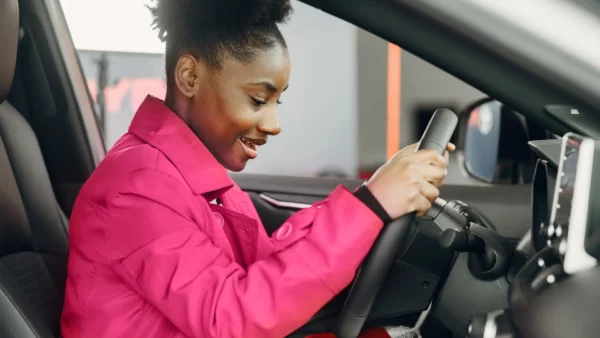Since 1994, every new driver that wants to be licensed to drive in Ontario has to go through a three tier graduated licensing system that allows them to learn under controlled conditions over 2-5 years. Levels include G1, G2 and G.
G is a full, unrestricted license. G1 and G2 drivers are required to maintain zero blood alcohol at all times (and zero THC), and there are additional restrictions in terms of which roads you are allowed to drive on, what times you are allowed to drive and the number of passengers you are allowed to transport.
To become a fully licensed driver in Ontario, every new driver must go through a graduated licensing program that allows them to learn in a controlled environment. The program applies to drivers of any age, and may even apply to drivers with foreign experience if they are not able to prove that experience.

- Graduated licensing in a nutshell
- Taking the G1 driving test
- Taking an approved driving course
- Driving with your G1 while supervised
- Taking the G2 driving test
- Drive unaccompanied with your G2
- Taking the G driving test
- Graduated licensing FAQs
Graduated licensing in a nutshell
- G1 license (learner’s) – Minimum time in G1: 12 months, or with approved driving course: 8 months
- G2 license (probationary) – Minimum time in G2: 12 months
- G license (full license) – Maximum time to get full G license: 5 years
G1 license regulations & restrictions:
- You must be at least 16 years old and pass a knowledge test to get your G1 permit.
- You must have zero blood alcohol and THC.
- Every person in the car must wear a seatbelt.
- You must be accompanied by a fully licensed driver with at least 4 years driving experience.
- You may not drive on 400-series highways or certain other roads.
- You may not drive between midnight and 5am.
- You must have your G1 for 12 months before taking a test for your G2.
- If you pass an approved driving course, you may take your G2 test after 8 months.
G2 license regulations & restrictions:
- You must be at least 16 years old and pass a driving test to get your G2 permit.
- You must have zero blood alcohol and THC.
- Every person in the car must wear a seatbelt.
- You can drive unaccompanied.
- If you are age 20 or older, or if you are accompanied by a fully licensed driver with at least 4 years driving experience, there are no additional restrictions.
- If you are 19 or under, and unaccompanied1,
- For the first 6 months with your G2, you can only carry one other person who is 19 or under between midnight and 5am.
- After 6 months with your G2, you can only carry up to 3 other people who are 19 or under between midnight and 5am.
- You must have your G2 for 12 months before taking a test for your full G license.
1. The restrictions on carrying passengers under 20 years old do not apply if the passengers are immediate family members of the driver.
General restrictions:
- From the moment you pass your G1 test, you have 5 years to get your full G license. Otherwise, you must begin the entire process again.
- Regardless whether you have a G1, G2 or full G license, all drivers under 22 years old must maintain zero blood alcohol and THC.
Drivers with foreign experience:
- Drivers who can prove that they have at least 24 months of foreign driving experience in the last 3 years may be able to bypass the graduated licensing program and simply take the driving test for their full G license.
- Drivers with less than 24 months of foreign driving experience may be able to bypass some parts of the program.
The first step – G1 test
If you are a young person (16 or older), a person who for some other reason has not had a driver’s license in the past 3 years, or a person who is new to Canada and can’t show proof of sufficient foreign driving experience, you will have to go through the steps of Ontario’s graduated licensing program in order to become a fully licensed driver. The program takes a minimum of 20 months and a maximum of 5 years.
The first-level license is called a G1. In order to get a G1, you will need to pay a fee of $159.75, pass a vision test, and then a test to prove your knowledge of basic rules of the road. The G1 test is broken up into two sections, and you need to get at least 16/20 (80%) on each section. There is no driving test.
All of the information you need to pass the G1 test is in the Driver’s Handbook. Make sure to study the handbook fastidiously. Before you go for your test, go online and complete as many practice tests as possible.
You don’t need to pre-book your G1 test. Simply go to any DriveTest centre at least one hour before it closes. You will have to show valid ID that shows your full name, signature, a picture and your date of birth. Acceptable ID includes:
- A valid passport (Canadian or other)
- A valid citizenship card
- A valid permanent or temporary immigration document
If the document you present does not have all the required information (perhaps it has your maiden name), you may show other documents that help to prove your identity. For example, a marriage certificate can be used to prove your married name, or a student card or health card may be used to satisfy the signature requirement if there is no signature on your primary ID.
In some cases the knowledge test will be conducted with paper and pencil, and in other cases you will complete it on a computer at the testing facility. Depending on how busy the testing centre is that day, you should get your results right away. If you pass, away you go. You will walk out with your G1 license. If you fail, you can pay another fee (only $15.75) and take the test again the same day, time permitting.
Note: When you get your G1, most insurance companies don’t require your parents to add you to their insurance policy because you can only drive with a licensed adult, and presumably, their insurance will cover you. If you have a new G1 driver in the house, it is a good idea to let your insurance broker know, however.
Get an auto insurance quote in minutes.
Step 2 – Taking an approved driving course (if you’re smart)
The law doesn’t currently require new drivers to take any kind of formal driver’s education course. But there are at least three good reasons to do so:
- It will allow you to get your full license 4 months sooner;
- It will prepare you for your G2 driving test; and
- It will save you money on insurance once you get your own policy, or when your parents add you to their policy.
A good course will cost you close to $1,000, but it will probably save you double that or more in the first few years that you have to pay for insurance. The choice is yours, but if your goal is to get your full license as quickly as possible, and then pay as little as possible for insurance, you should definitely do driver training.
If money and time aren’t enough to convince you, the defensive driving principles that you learn in driver training may make you a more confident driver once you get out on the road, and could even save your life.
Step 3 – Driving with your G1 while supervised
You’d be forgiven for thinking that step 3 in the graduated licensing process might be taking the G2 driving test, but the reason you’re given 8 or 12 months with your G1 license is so that you can gain some valuable driving experience under the watchful eye of a seasoned driver. Take advantage of this time. There’s no requirement to put in a particular number of driving hours before testing for your G2, but logic dictates that if you put in 50 or 100 hours of driving over that time, you will be a much more competent and confident driver than if you just go out 5 times for half an hour.
Remember that you have the following restrictions when driving with a G1:
- You must be accompanied by another driver who has been fully licensed for 4 years.
- Your accompanying driver
- must sit in the passenger seat beside you.
- must have zero blood alcohol and THC if under 22
- must have blood alcohol under 0.05% if 22 or older
- You must have zero blood alcohol and THC.
- Every person in the car with you must wear their seatbelt.
- You cannot drive on 400-series highways.
- You cannot drive between midnight and 5am.
If you’re a parent and you’re supervising your child as a G1 driver, thank you for your time and for your patience. Every hour you put in will improve the chances that your offspring will be a safe driver. Start with simple, short drives in and around your neighbourhood at times when there is minimal traffic, and gradually increase the length and complexity of the drives. Try to put your novice driver in as many different driving conditions as possible while they have their G1, including rain, rush hour and night time driving. They’ll need to learn eventually. Better that they learn while they have some backup.
Step 4 – The G2 driving test
When it’s been at least 12 months since you got your G1 license (8 months with driver training), you can take a road test for your G2 license. This will probably be your first official driving test, but if you’ve taken an approved driver training course, your instructor will give you lots of tips in terms of what to watch out for in advance.
You need to book your G2 test ahead of time at https://www.drivetest.ca or by calling 647-776-0331 (GTA) or 1-888-570-6110. You will need to know your driver’s license number and you will be asked about your preferred test dates and locations. You will be given a date within a maximum of 42 days from when you call, and often sooner.
The road test will cost $53.75. Be at the testing facility at least 10 minutes before your scheduled time.
You will need to bring a car. Most people bring their parents’ car. Some driving schools will let you use one of theirs. Whatever car you bring, make sure that its registration, plates and insurance are up-to-date, that the car is in good working condition (all signals work etc.) and that you are familiar with all the features in advance. Make sure you know how to adjust the seat and mirrors, how to work all the controls, including all lights and signals.
The test will last about 20 minutes and will test your basic driving skills, including:
- Starting
- Stopping
- Exiting a parking lot into traffic
- Reversing
- Parallel parking
- U-turns
- 3-point turns
- Passing
- Turning
- Proper signaling
- Obeying all lights and road signs
- Driving through different types of intersections
The G2 road test will be conducted on local roads and will not require you to go on the highway. You should be told right away if you passed, and get your license upgraded to a G2 right away. If you don’t pass, you can rebook another test. The examiner will give you feedback on what you did wrong. You’ll have to pay the $53.75 road test fee again.
Step 5 – Drive unaccompanied with your G2
Once you get your G2, make sure to get auto insurance. In most cases, you can be added as an occasional driver to a parent’s policy. If there is no vehicle where you live, you can certainly drive a friend or relative’s car from time to time without being named on the policy, but if you live with other licensed drivers, you need to be added to the policy. It won’t be cheap, but hopefully you invested in a driving course to make it sting a little less.
When you get your G2, you’ll be able to drive on your own. You’ll also be able to drive on major highways. Take advantage of this opportunity to practice your skills. It’s important to note that you won’t be allowed to take your G test until you sign a “Declaration of Highway Driving Experience”, stating that you’ve driven a minimum of 5 times either on a 400-series highway or on another highway with a speed limit of at least 80 km/h.
Remember that you still have restrictions on your driving as follows:
- When driving, you must have zero alcohol or THC in your blood.
- If you are 19 or under, and driving unaccompanied after midnight:
- For the first 6 months after getting your G2, you can only have one passenger 19 years of age or younger.
- After 6 months, you can only have up to 3 passengers who are 19 or younger.
Step 6 – Taking your G driving test
Twelve months after you get your G2 license, you’ll be able to do your G test. This is it! The final driving test. And if you pass, you’ll get your full unrestricted G license.
As with your G2 test, you need to book your G test ahead of time by calling 647-776-0331 (GTA) or 1-888-570-6110, or you can book it online at https://www.drivetest.ca. You will be asked for your driver’s license number and when and where you’d like to do the test. You are guaranteed a date within 42 days, so long as that date is at least 12 months after you got your G2.
The road test will cost $91.25. Be there at least 10 minutes early.
You need to bring a car. Make sure that the car you bring has its registration, plates and insurance up-to-date, and that it’s in good working order. If the examiner doesn’t feel that the car is safe, they may cancel your test and require you to book another one. If the car is not one that you’re familiar with, take some time well in advance of your test to familiarize yourself with all the features and controls.
Before you begin the test, you will have to pass a vision test and read and sign a “Declaration of Highway Driving Experience”.
The test will usually last 30 to 40 minutes, and will test some of the same things as the G2 test, as well as more advanced driving concepts, including:
- Left and right turns
- Turn from a stopped position
- Going through an intersection with a stop sign
- Going through an intersection with no lights or stop sign (through intersection)
- Entering a freeway
- Driving on a freeway
- Exiting a freeway
- Changing lanes
- Stopping safely by the side of the road
- Re-entering traffic after a roadside stop
- Taking a curve
- Driving through a business section of town
- Driving through a residential section of town
- Parallel parking
- Re-entering traffic after parallel parking
- Three-point turn
The examiner will be watching for the following:
- That you fasten your seatbelt and keep it fastened the whole time;
- That your hands are properly placed on the wheel at all times;
- That your speed is within the speed limit, and appropriate for the conditions at all times;
- That you obey rules about right-of-way;
- That you use your signals appropriately;
- That you are aware of your surroundings and check your mirrors frequently;
- That you leave sufficient space around you at all times; and
- That acceleration and braking are safe and smooth.
You will find out at the end of the test if you passed. If so, you should get a temporary G license right away. Your permanent license will be mailed to you. If you don’t pass, you can rebook another test. Regardless whether you pass or fail, the examiner will likely give you feedback on what you did wrong. Pay attention, especially if you fail. If you need to rebook, you’ll have to pay the $91.25 fee again.
What else is different about being a novice driver?
During the 20 months to 5 years when you are driving under a G1 or G2 license, you are considered a novice driver. As stated in this piece, there are a number of restrictions that you must adhere to while you are a novice driver.
In addition to the driving restrictions, demerit points and license suspensions also work differently for novice drivers. Whereas a fully licensed G driver will face a suspension if they accumulate 15 demerit points within a span of 3 years, a G1 or G2 driver could be subject to a 60-day suspension after only 6 to 8 demerit points.
Why graduated licensing?
Young drivers have always had the reputation for being less careful than older drivers, taking more risks on the road and exercising worse judgement in various driving situations. Some of this reputation may be the result of a bias against younger drivers, but traffic accident statistics clearly show that young drivers are much more likely to get into serious accidents than their older counterparts. In fact, drivers aged 16-19 are 4 times as likely to die in a car accident as drivers aged 25-34, and nine times as likely as drivers aged 45-54.
In 1994, the Ontario government followed the advice of road safety experts, and introduced a graduated licensing program consisting of three stages. The earlier stages (G1 and G2 licenses) imposed restrictions on behaviours that had been proven over time to increase the frequency and severity of accidents, including driving while impaired by alcohol, driving with other young passengers in the car, driving on high-speed roadways and driving late at night. With the subsequent legalization of cannabis, drivers with a G1 or G2 license are now also restricted from having THC in their blood.
What do you need to drive in Ontario?
Any time you are driving on Ontario roads or highways, you’ll need to have your driver’s license with you. You also need to have proof of the vehicle’s valid and up-to-date registration and insurance. Your rear license plate must have the validation sticker attached in the correct position.
Graduated licensing FAQs
How old do I need to be to get my G1 in Ontario?
16 years old.
How long does it take to get your full G license in Ontario?
20 months to 5 years. From when you pass your G1 test, you’ll need to wait 12 months until you can take your G2 test (8 months if you take an approved driving course). Then you’ll need to wait an additional 12 months from when you pass your G2 test until you can take your G test. If you don’t get your G license in 5 years after passing the G1 test, you’ll have to start all over.
Is there a way to get my full license faster than 2 years?
If you take an accredited driver education course as a G1 driver, you can go for your G2 test 4 months earlier than usually, meaning that you can go through the entire graduated licensing program in 20 months instead of 24.
Do I need to go through graduated licensing if I have foreign driving experience?
Sometimes. Drivers from the United States or certain other countries may be able to simply trade their license in for an Ontario G license. If your driving experience is from a country that doesn’t have a reciprocal agreement with Ontario, you’ll need to show proof that you have a minimum of 24 months’ driving experience in the last 3 years in order to get your full G license. Any less experience, and you will have to enter the graduated licensing program at the appropriate spot. For instance, if you have a year of experience, you may be able to go straight to your G2 test.
How do I prepare for my G1 knowledge test?
The G1 test is all based on information contained in the driver’s handbook. Before going for your test, study the handbook as much as possible, and make sure to go online and complete at least a few practice tests.
How do I pass my driving test?
You will pass your G2 or G driving test if you demonstrate knowledge of all relevant road rules and signs, and drive safely, and according to best practices. The best way to maximize your chances of passing is to take an approved driver training course, where you will get tips on how to pass.
How long does the G2 and G driving test take?
The G2 test usually takes about 20 minutes. The G test takes between 30 and 40 minutes.
How much alcohol are you allowed to consume as a G1 or G2 driver?
Zero. In fact, all G1 and G2 drivers as well as all drivers aged 21 or younger must have zero blood alcohol and THC while driving.
What type of license allows me to drive by myself?
In order to drive without another licensed driver supervising you, you must have a full G license. You may drive unaccompanied as a G2 driver, but you are subject to restrictions in terms of how many young passengers you carry between midnight and 5am.
Are there any restrictions related to a full G license?
No. Other than following the rules of the road. The only restrictions are in terms of the types of vehicles you may drive. A G license allows you to drive most cars, light pickup trucks and vans.
What are the fees for getting a G1, G2 and G license in Ontario?
Fees for G1, G2 and G tests are as follows:
| Service | Fee |
| G1 knowledge test | $159.75 |
| G1 retest | $16.00 |
| G2 road test | $53.75 |
| G road test | $91.25 |
| Five-year licence | $90.00 |
How many mistakes are allowed on a G1 knowledge test?
4 per section. Maximum of 8. The G1 test is made up of two sections, each containing 20 questions. If you get more than 4 wrong in either section, you will fail the test.
How many mistakes are allowed on a G2 and G driving test?
There are no set number of mistakes allowed on a driving test. One mistake could cause you to fail if it is a safety issue like failing to stop or speeding. If you have problems with parallel parking or if you don’t check your mirrors quite as often as the examiner would like, you may pass anyway.
Can I rent a car with a G1 or G2 license?
No. You need a full G license to rent a car.
Why Is Graduated Licensing Important?
New and young drivers have been proven to be at higher risk of serious crashes, particularly when they use alcohol or undertake other risky activities. Graduated licensing allows new drivers to learn under controlled conditions. The G1 and G2 stages restrict higher-risk activities like late night driving, driving on major highways, driving with other passengers your age, and driving with a small amount of alcohol or cannabis in your system.
How long after I get my G2 can I do a road test for my full G license?
Twelve months (aka 1 year). You need to book your G test ahead of time by calling 647-776-0331 (GTA), 1-888-570-6110, or going online at https://www.drivetest.ca/. When you pre-book the date of the test, the system won’t allow you to book a date that is less than 12 months after the effective date of your G2 license.
Looking for car insurance?
Speak with a Mitch Insurance broker today to get an Ontario auto insurance quote.
Call now
1-800-731-2228








How long to get g2 after g1?
You have to wait 12 months but if you go to a certified driving school then you only have to wait 8 months AND you get a discount on your insurance!
Thanks, Billy, for the question, and thank you, Madison, for the correct answer. 8 months with driver training, one full year without.
I went to drivers school and passed it i have a G2 license do i have to wait 12 mths to take my G road test or is it 8 mths with driving school
Hi William. Thanks for your question. Yes, unfortunately you have to wait 12 months to take your G test. Driver training can shorten the waiting period for your G2, but not for your G.
I have a professional drivers license back home and i have g1 now mto told me that i am allowed bto go straight for G thats why i booked my G test this july.. my question is do i still get g2 if im failed for my g test
I heard that if you I had a g license before that you can go from a G2 to a full G quicker than 12 months. Is that correct?
Also, I have the ability to use a car with a backup camera for my G2 test. Are you allowed to use it to park in a parking spot?
Because of pandemic, driving centres and driving schools were close almost 1/2 years. instructors and learners couldn’t continue their lesson. To getting G1 to G in five years is really tuft for them who got g1 before pandemic. Is authority will consider the situation and extended the time frame to getting G1 to G licenses In five years? I hope authority will consider these special situation for the G1 license holder. Thank you.
What kind of cars are allowed to drive with a G license?
I have a 40 year old friend who never had a driver’s license but wants one now. He knows how to drive and was wondering if he can get his G license right away or does he have to do the graduating G1 and G2 first.
Thank you
What if its been 12 months after giving g1 and I do not want to give g2 now, I mean if this one year period exceeds and then I give g2 . Would there be any issue? As i need more time yet
Hi Ratandeep, your G1 or G2 licence expires five years after the date you got your G1. If you haven’t passed the G1 and G2 road tests and received your full G licence within the five years, you’ll need to start the process over again.
I drive for over 60 years in mostly in candada and abroad, than I failed, to stop at a red light and had an accident , both myself and the lady I collided with didn’t really got hurt. The cars were not in a good shape.
The policeman said to me you better say u r at fault pay the fine (400) and u will be free!!!??not true, I am to go the do all the tests of a 16 that never drive!! Including everything plus driving.
I an a healthy 82 year old taking care of my disabled daughter, that on top of the disability, was diagnosed with metastasized breast cancer, and now I drive her for treatment, and and test at least 2/3 times! I know it was my fault, but it almost doesn’t sound right or fare for me to stop driving my daughter for the many treatments and dr appointment tests etc, I always was a good smart driver, but this put me in completely different level, I end up using Ubers everywhere
Up to 4/6 times a week and more, very expensive, and I must say these drivers are reallllyyy BAD, not sure how they got allowed to drive people around, some of them don’t spk English and don’t understand the GPS lady, I end up helping how to get to the hospital etc, they do not drive safely, and my daughter and I must use their services, pretty ridiculous, and said.,my daughter used to drive but lost her licence because one of the stroke she had paralyzed her on her right and left her with seizures so her licence was taken away for good, she is a very young 52 year old and feels kicked in the face every time we driving an Uber!!!!all that story is , that I am being treated like a bad driver of 16 years old. I did the write n test not terrific now I have to do rulings, I know most the signs and fir sure to do or not todo while driving, so how can we deal with the mature citizens they drove all their lives to get back without his nerve nerve king test
Will appreciate your ideas and who to approach!!!
Hi Nora,
Thank you for sharing your story with us, and we’re sorry to hear about the challenges you and your daughter are facing. Your local DriveTest Centre is the best place to get more information on driving tests for mature citizens and any accommodations that can be made to make things less stressful. https://drivetest.ca/licences/seniors/